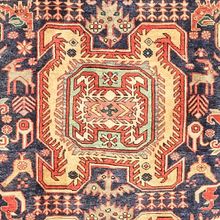Ardebil Rug
| Ardebil Rug | |
|---|---|
 Design of Ardabil Rug (Rugman) | |
| General information | |
| Name | Ardabil Rug |
| Original name | قالی اردبیل |
| Alternative name(s) | Ardabil Carpet |
| Origin | |
| Category | Village, City |
| Technical information | |
| Common designs | Geometric, Herati (Fish), Lachak Toranj |
| Common colors | Turquoise, White, Ceram, Navy Blue, Green |
| Dyeing method | Natural, Synthetic |
| Foundation material | Wool, Silk |
| Weaving Technique | Cotton |
| Knot type | Symmetrical (Turkish), Asymmetrical (Persian) |
Ardabil rugs originate from Ardabil, located in the East Azerbaijan Province but is today the Ardebil Province of northwestern Iran. Ardabil has a long and illustrious history of Persian carpet weaving. The reign of the Safavid Dynasty in the 16th and 17th centuries represented the peak of Persian carpet making in the region. The name Ardabil comes from the Avesta (The sacred book of Zoroastrians) with the word Artavil literally meaning a tall holy place. The weavers in Ardabil ply their craft using Persian knots. One of the most famous carpets in existence today is a Persian carpet from Ardabil. This magnificent masterpiece measuring 34' x 17' is hanging on display in the Victoria and Albert Museum in London, England.
History
Ardebil, also spelled Ardabil, is a city in what had been the East Azerbaijan Province but is today the Ardebil Province of northwestern Iran, and is the capital of that province. Ardebil is an ancient city with historic architecture. THE Ardabil Carpets, also known as the “Sheikh Safi” carpets, were purchased from this city after originally being woven for its Sheikh Safi al-Din Mosque. The carpets are famous, and are preserved in the Victoria and Albert Museum in London and the Los Angeles County Museum of Art in California. Ardebil rugs are known in the market from the first quarter of the twentieth century.
After World War II a carpet boom occurred in thr Western markets, and Ardebil weavers changed their weaving styles and designs to attract new consumers. The rugs were changed to a wool foundation and wool pile with geometric Caucasian designs. Most formats range from mats to rugs approximately ten feet by six feet, following Caucasian practices. No room-size carpets were made during this period. Various background colorations were used and were suitable for the Western markets. The production in rug weaving grew dramatically, and most househol kept a loom for weaving. During the 1970s some weavers switched to a cotton foundation in order make room sizes. Ardebil carpets were sold in large quantities in the Tehran and Ardebil bazaars export.
In the late twentieth century some experienced weavers began making rugs and carpets with a silk foundation and a silk pile by commission for Ardebil and Tehran dealers. These weavings were high in grade quality and featured important, traditional designs. The carpet weaving industry continues to provide a better lifestyle and income for the people in the Ardebil Province.[1]
Materials
Foundation and Pile
The rugs and carpets have a cotton foundation and a wool pile.[2]
Techniques and structures
Color and dyeing
Traditional colors were us field and borders.[3] Some modern weavers have added colors such as turquoise and purple to the more traditional red, pink, ivory, green, and blue.
Motifs and Designs
Contemporary rugs of this area employ designs similar to Caucasian designs.[4] Also these carpets were similar to Tabriz designs but in a lower grade quality. The designs are floral, with palmettes, leaves, and vines, in either a medallion or allover pattern.[5] Some modern weavers have begun to favor bold geometric patterns over the traditional Mahi (Herati) design.
Weaving techniques
They have (symmetrical) knots at a density up to 160 per square inch on a cotton foundation.[6] Most of the carpets seen in the market are not woven to perfection and often have broken design elements and crooked shapes. They were mainly produced in limited quantity in small room sizes for domestic use.[7]
Gallery
- Ardabil Carpet-Victoria Albert Museum.jpg
Ardabil Carpet (1539-1540), Victoria and Albert Museum
- Ardabil Carpet-Lacma Museum.jpg
Ardabil Carpet (1539-1540), The Los Angeles County Museum of Art
- Ardabil Rug-Djoharian Oriental Rugs.jpg
Ardabil Rug-Djoharian Oriental Rugs, JOZAN: Rug news and antique rugs.
See also
Ardabil Carpet, Sheikh Safi carpet, Victoria and Albert Museum, The Los Angeles County Museum of Art, Tabriz Rug, Tehran Rug
References
Bibliography
- Abraham Levi Moheban, 2015, The Encyclopedia of Antique Carpets: Twenty-Five Centuries of Weaving, NewYork: Princeton Architectural Press.
- Peter F. Stone, (2013), Oriental Rugs: An Illustrated Lexicon of Motifs, Materials, and Origins Kindle Edition, North Clarendon :Tuttle
- JOZAN: Rug news and antique rugs.